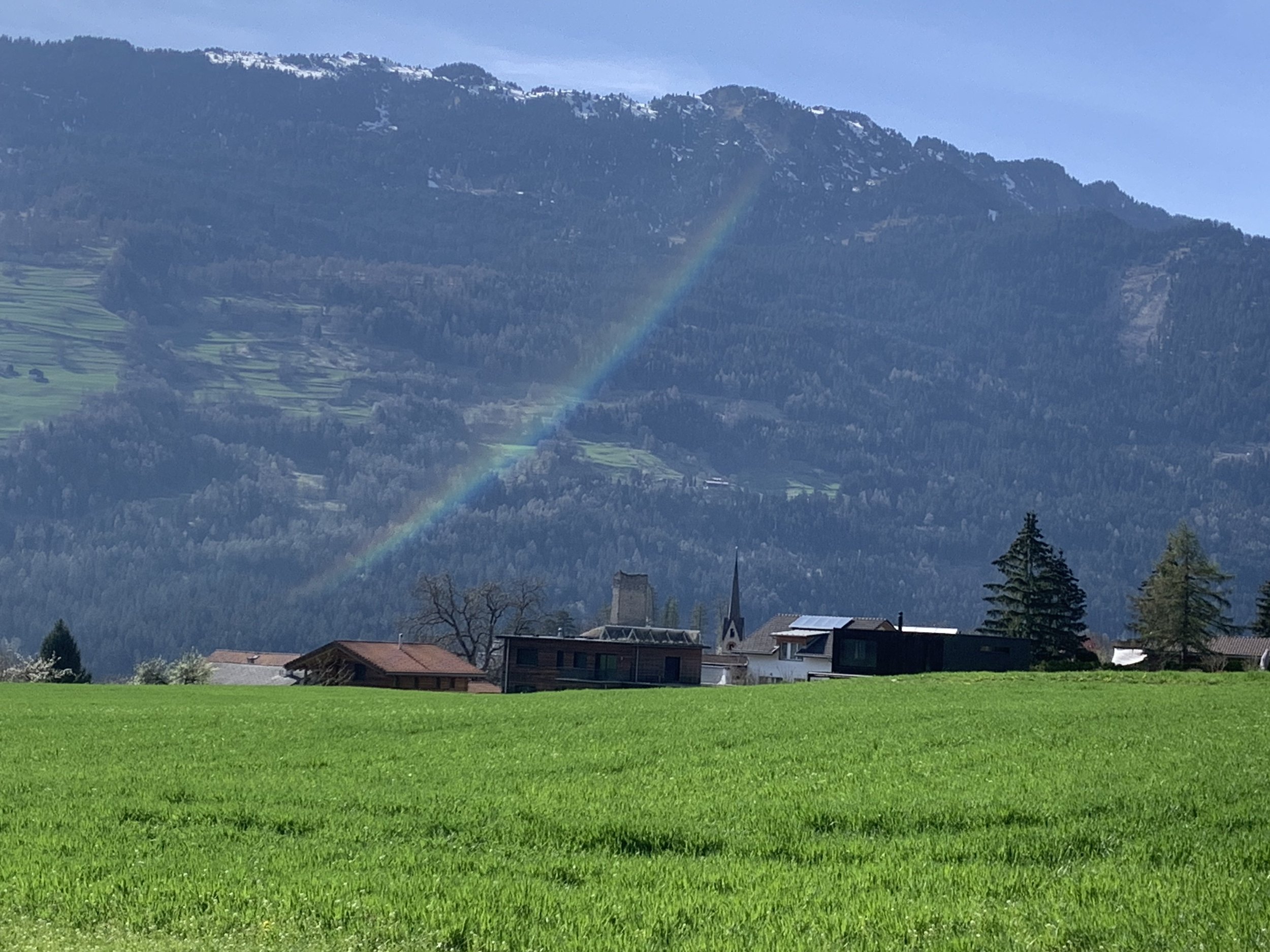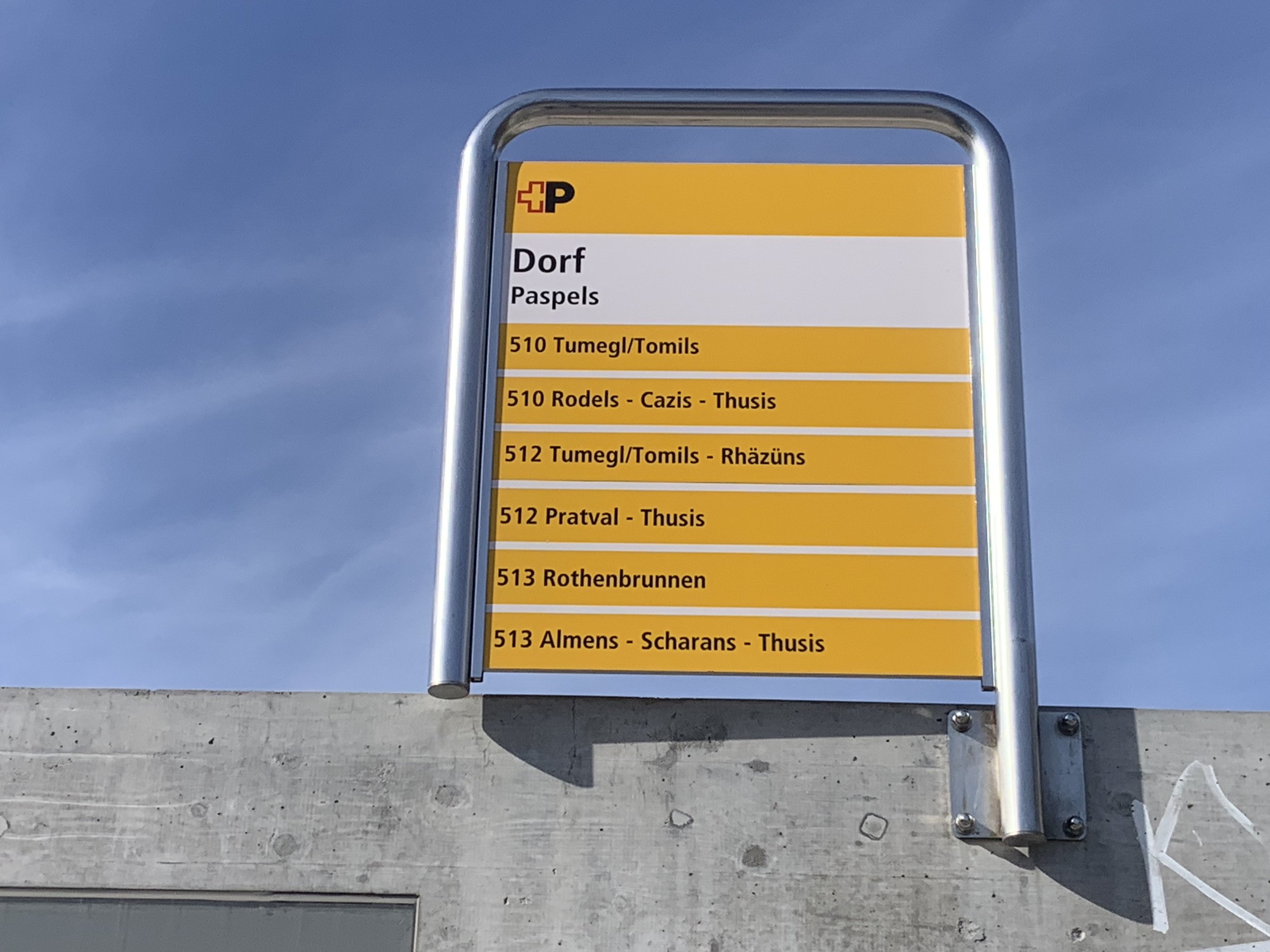Rural Transport Swiss Style - and an Invitation to Action
This is Paspels:
I was there last week, and I’d like to show you round to illustrate how the Swiss do rural transport.
Paspels is in Graubünden, the largest and most remote canton of Switzerland. The population density is 29 people per km; less than half that of Scotland and just 20% of the population density of Wales.
Paspels itself is a village of 475 people located between Thusis and Rhäzüns. Along with four other villages, it makes up the municipality of Domleschg. Collectively, they have a population of 2,000.
In summary, there aren’t many people. (There are lots of cows).
Rural buses
Here’s Paspels village bus stop:
And here are the buses that serve Paspels:
The core service is the 512. This runs between Rhazuns and Thusis every hour, primarily serving the villages of Rothenbrunnen and Paspels.
The 513 is the local workhorse. That runs every thirty minutes, also between Rhazuns and Thusis. But whereas the 512 serves the bigger villages, like Paspels, the 512 winds up and down the local hills to serve all the smaller villages at the end of dead-ends.
Here’s the 513 on its way back from dropping into Almens (population 228), which it does every half hour:
The 510 is an out-and-back route from Thusis that serves the villages that can’t be served by the 513.
These run until around 8pm, after which a demand-responsive bus service takes over, which runs until 11pm - except on Fridays and Saturdays, when it runs until half past midnight.
Now, I’ve just written that all down deadpan, but just read it back.
Every tiny village in the area is connected by a frequent bus service from 0500 to 2300. Bigger villages (though not quite at the heady heights of 500 people) like Paspels have both a fast direct bus and a slow connecting bus.
Like so many aspects of the Swiss public transport system, it’s jaw-dropping if you’re from the UK.
Connected
Moreover, as happens all over Switzerland, the buses are timed to meet the trains.
The main destination from here is Chur: the capital of Graubünden and the only proper city.
The 512 from Paspels arrives into Thusis at 59 minutes past the hour. Three minutes later at 02 minutes past the hour, the Regional Express train to Chur departs. That means that the whole journey takes less than an hour. And because the buses also connect in the same way at the Rhäzüns, at the other end of the route, they combine to make a journey of less than an hour, every thirty minutes. Here is the train to Chur about to leave. The next picture is taken from the same spot. You can see the buses just outside the station:
Moreover, because all the buses are timed to meet the Regional Express train, they’re also timed to meet each other. Which means as well as getting easily to the county town and the main city, you can also get from Paspels to any other village in the area with a simple hop-off, hop-on connection in Thusis.
I can’t emphasise enough what this means in practice. Living in Paspels car-free, as I did last week, means you are as free to go places as a driver would be. We often talk about rural transport as being a deeply complex problem, but it really isn’t. I’m a big fan of innovation when innovation is needed. But what rural areas need is not innovation but buses.
What good looks like
However, there are a few points to note.
1) These are good buses. They were clean, smart and all arrived perfectly on time. Note the connection time at Thusis is 3 minutes. That works because the bus runs exactly when it says it will.
2) It's not just about the bus service but the timetable. The magic is not the fact that Paspels has a decent bus service to Thusis, but the fact that by connecting at Thusis in 3 minutes, Paspels actually has a virtually direct connection to everywhere in the area and to the national rail network.
However, it’s also worth noting that when it’s good, people use it. Look up at that picture of the bus stop. The shelter is full of people waiting for the bus. We travelled on quite a few buses. They were well-used.
This is normal
One thing I want to make clear is that Paspels is not unusual. I wasn’t there because Paspels had better transport than most Swiss villages. I was there because a family in Paspels wanted to come to London the same week we wanted to go to the Alps. So we swapped homes. It could have been any village. I also want to pre-empt the idea that this is a service for tourists. Paspels has no visitor attractions and no ski runs. It’s just a village. With cows.
A Challenge
I’m now going to set you a challenge. Why don’t we create a “Mini-Switzerland” in your area? Do you work for the local council or a bus operator or a rail operator? Could your patch be Mini-Switzerland?
This kind of thing can work: let me tell you about Mini Holland.
Mini Holland
Mini Holland is what happens when a borough gets serious about walking and cycling.
Funded by Transport for London back in 2016, the programme gave three outer London boroughs the chance to redesign streets to prioritise people over traffic. We’re talking protected cycle lanes, better crossings, low traffic neighbourhoods and genuinely pleasant public spaces.
The reason it was called Mini Holland is because these are all ideas that have been proven to work in the Netherlands. Instead of coming up with radical new ideas; let’s just learn from the best in class and do what they do.
It’s not about turning London into Amsterdam overnight, but proving that even car-dominated suburbs can shift the dial towards safer, healthier, more liveable streets with the right political will (and a bit of cash).
I know all about Mini Holland because I live in the first one. In 2016, the street I live in became part of a Low Traffic Neighbourhood and our local high street was pedestrianised. A few years later, our local A-road gained protected cycle lanes.
Today, Walthamstow genuinely is a Mini Holland, with a cycling and walking infrastructure that would not look out of place in a Dutch city.
So…
With that inspiration in mind…
How about we create…
Mini Switzerland!
Just as Walthamstow was able to create Mini Holland with the right political will and investment, maybe where you work can prove that it’s possible to do rural transport well?
This won’t be an overnight journey. For inspiration, have a listen to Simon Munk talking about the genesis of Mini Holland on the podcast. They were working on it before TfL turned up with the lump of cash.
The idea here would not so much be to hope for a single programme to emerge from the sky (I am, as you know, not a big fan of ring-fenced funding pots) but instead to create a clear destination. One of the simplest tricks in leadership is that it’s easy to get somewhere if you know where you’re going.
A local area could set out to achieve the key characteristics of a Swiss-style transport network. These include:
Integrated bus and rail timetables
Integrated bus and rail ticketing
Physically integrated bus and rail interchanges
All services running every hour
Exceptional punctuality
High quality of service delivery
Pride
Does that sound like where you work?
No, thought not.
Does it sound like where you want to work?
Great! Let’s make it happen.
The magic of Switzerland has been a multi-decade project. It didn’t happen overnight. But we’ll never reach a destination unless we start.
As a minimum, I think we need two of the following:
1) An enthusiastic council
2) An enthusiastic bus operator
3) An enthusiastic rail operator
To start with, we don’t need to know how we’re going to do it or where the money will come from. Remember, this is about a destination.
Like to Try this where you are? - An Offer from Me
I’d really like to see this happen.I’m offering three free consultancy sessions to help any local area explore becoming a Mini-Switzerland.
I don’t promise miracles but I do promise support, insight and enthusiasm. Let’s make something special happen.
How Can I Help You?
Click here for services
👋 I'm 𝗧𝗵𝗼𝗺𝗮𝘀. I help organisations like yours drive 𝗶𝗻𝗻𝗼𝘃𝗮𝘁𝗶𝗼𝗻, deliver 𝗰𝗵𝗮𝗻𝗴𝗲, and achieve 𝗳𝗮𝘀𝘁𝗲𝗿 results, drawing on 20 years of leadership across public and private sectors.
🚀 I offer 𝘀𝗽𝗲𝗮𝗸𝗶𝗻𝗴, 𝗺𝗲𝗻𝘁𝗼𝗿𝗶𝗻𝗴, and 𝗰𝗼𝗻𝘀𝘂𝗹𝘁𝗶𝗻𝗴 that energise teams, shape strategies and remove barriers to change. Whether you aim to accelerate innovation, drive change, or inspire your people, I’m here to help. Let’s talk!







